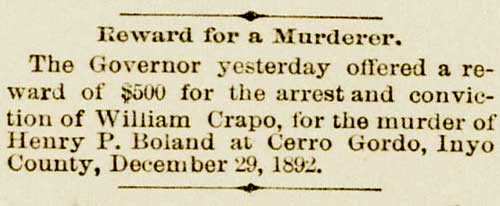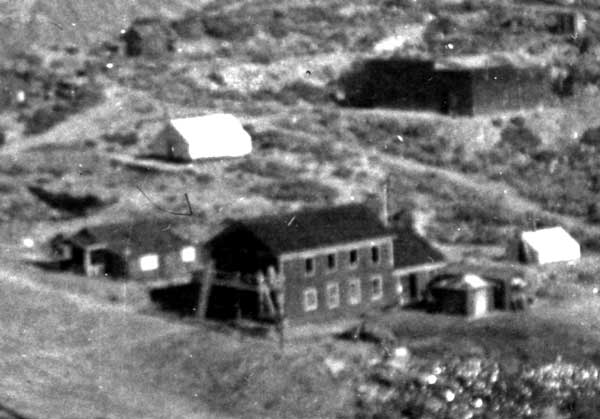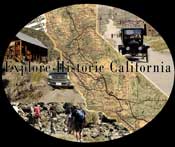An email enquiry from a reader prompted this story.
 |
|
The Sacramento Daily Union newspaper
reported, January 3, 1893, that a reward of $500 had
been offered for William Crapo, the presumed killer
of Henry Boland. Crapo was never found. |
By 1892, the mines at Cerro Gordo had boomed and busted, but
Thomas Boland still hung on to hope and struggled to keep
them open. In addition to invested interests in the fading
mining camp’s silver deposits, Thomas was chairman of the
Inyo County Board of Supervisors, and he owned a general
store in Keeler, at the shore of Owens Lake. Thomas managed
to keep the mines in working order, but couldn’t even pull
out the low grade ore that had barely paid for Archie
Farrington’s retimbering of the Belshaw shaft before he took
over the Union’s lease.
The town was going to the ghosts, as populations dwindled
and buildings sat empty and in disrepair. Gone were the days
when laughter and cheers and music accompanied the whistling
of the never ending wind, along with the daily sounds of gun
shots and angry shouts and fist fights at the saloons and
dance halls. The charred remains of Maggie Moore’s dance
hall and the eight other buildings that burned with it that
fateful night in March, 1880, had long disappeared, as had
Maggie’s girls. Lola Travis Palace of Pleasure stood quiet,
Lola herself, well on her way to a respectable life with a
husband in Kern County. The town was so quiet and desolate,
that had the failed Cerro Gordo Social Union, a literary and
oratorical club, attempted to resurrect itself minus the
competition of Lola and Maggie’s girls, there would have not
been enough men to attend.
The jingle bells of the mules’ teams that pulled the freight
wagons and the dust of the twice daily stagecoaches all but
haunted the Yellow Grade Road. Occasional wagons with
supplies came by, but those would have been few and far
between. The post office established November 4, 1869, had
closed January 12, 1887, with mail diverted to Keeler at the
bottom of the Yellow Grade Road. But with Thomas Boland’s
investments and the men he needed to watch over them, the
post office reopened on September 14, 1889 with Henry B.
Boland, Thomas’ brother, as the postmaster.
It was probably a relatively quiet December day, with only
the noise of limited mining activities to break the silence.
The wind would have been cold and brisk, and there may even
have been traces of snow on the ground. Henry Boland was on
his way to the post office where he had been working only
weeks before. John Dunphy was the new postmaster in his
place, and they could shoot the breeze while he picked up
his mail, if indeed there was any. With him was his friend
John Thomas.
Sixty feet from the post office, was William “Billy” Crapo’s
house. Billy was a well educated French Canadian, now the
oldest resident in the faded camp. He was well respected as
a civil engineer, and had spent many years working in the
mines. For a brief time in 1880, when the camp was still
hanging on to life, he was postmaster, as Henry Boland had
more recently been. Henry and John may have paused for a
brief moment before they reached Billy’s house and made note
of the political differences that Billy had with Thomas.
Even if they didn’t pause, bullets flying from Billy Crapo’s
house landed in Henry Boland’s back stopping him dead in his
tracks.
 |
|
The
Crapo House is the single story structure to the
immediate left of the American Hotel in this view of
Cerro Gordo prior to 1911. The white tent cabin
above the Crapo House stands on the spot that would
later become L. D. Gordon's home.
(L. D.
Gordon Collection, courtesy Doug Gordon)
|
A wagon was nearby, and John Thomas tried to get behind it.
More bullets began to fly before he could reach it, hitting
him in the eye, the right shoulder and the right wrist.
After the first shot, John had noticed Billy Crapo standing
at the door of his house where the sounds had come from.
Newspapers in Inyo County recorded the incident:
A telegram to
the following effect came over the wire
yesterday: - Henry B. Boland and John Thomas
were together walking toward the Post Office.
The house occupied by William Crapo is about
sixty feet distant from the office. After the
men had passed Crapo's house he opened the door
and fired after them. Boland fell dead at the
first shot, which struck in the back.
When Boland fell Thomas started to get behind a
wagon that was near, but before he could reach
it he got one bullet in the right shoulder one
in the right wrist. The full effect of the
wounds received by Thomas could not be stated
till examined by a doctor. After the first shot
was heard Thomas turned to look where it came
from and saw Crapo standing in the door of is
house. Doctor I. J. Woodin left Independence
yesterday afternoon for Cerro Gordo to attend to
Thomas. This tragedy is the outcome of the
trouble over the late election at Cerro Gordo.
H. B. Boland had been in business as a merchant
at Cerro Gordo several years; he was Postmaster
when killed; he was aged forty-two years and a
native of Pennsylvania. A widow and five
children are left to lament this awful tragedy.
John Thomas is a native of Wales and has been
mining at Cerro Gordo several years; he is a
foreman of the Newtown mine. He is a very quiet,
well disposed man and has no family; his age is
47 years. Crapo is one of the oldest residents
at Cerro Gordo; he is a well educated man, by
profession a civil engineer, but for many years
engaged in mining. He is a native of Illinois,
aged about 47 years. When the report reached
here Sheriff Gorman at once telegraphed a posse
at Keeler to go to Cerro Gordo, nine miles
distant, and arrest Crapo. The posse left Keeler
after six o'clock last evening. In the mean time
Under Sheriff Holland and Charlie Collios
started from Independence; they reached Keeler
soon after ten o'clock last night and pushed on
to Cerro Gordo. If Crapo resists he is a man who
would be hard to take. The latest report this
morning from Cerro Gordo is that Crapo had gone,
nobody knows where. Beyond Cerro Gordo is the
wilderness of deserts and mountains extending
hundreds of miles, all of which he knows. He
might make his way to Arizona. he has no
family.
|
The
Inyo Independent and Inyo Register later
followed up;
Nothing has been heard of Crapo since he
disappeared from Cerro Gordo. He is as
completely lost as if he had gone into a tunnel
and pulled the hole in after him. (Inyo
Independent)
If
Crapo is captured, he will probably be lunched.
(Inyo Register)
|
Posters were plastered all over Cerro Gordo and the Owens
Valley. A $500 was offered for Billy Crapo’s arrest. Rumors
were that he was last seen in the Lida Valley (near Death
Valley). Several years later, a miner at Cripple Creek, said
to have been involved in the Cerro Gordo fracas, was
murdered, but there was never any proof that Crapo was the
culprit and Crapo was never seen again.
Henry Boland’s brother, Thomas, spent many years and a great
deal of money trying to locate his brother’s killer. He took
it upon himself to claim Billy Crapo’s house as his own by
way of damages.
The old mining town bust and boomed a few more times over
the years, then went to caretakers and ghosts. The Crapo
House still stands near the 1871 American Hotel. The wanted
poster is said to still hang in the hotel, with a crude
portrait of Billy Crapo, the last badman of Cerro Gordo.
Perhaps one day someone will catch him.
|
 |
|
The Crapo House still stands today in the shadow of
the American Hotel at Cerro Gordo. |
Bibliography
From This
Mountain - Cerro Gordo
by
Robert C. Likes and Glenn R. Day
Community Publishing
Out of Print
Looking Back at
Cerro Gordo
by
Robert C. Likes
Rosedog Books (see link at left)
The Silver
Seekers
by
Remi Nadeau
Crest Publishers
Inyo Register
and Inyo Independent newspaper articles from
the collection of
Mike Patterson and
Jody Stewart
The Sacramento
Daily Union newspaper
Vol 84, Number 116, page 3.
January 3, 1893
Courtesy California Digital
Newspaper Collection
http://cdnc.ucr.edu/newsucr
